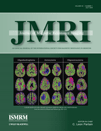Contrast-enhanced MRI of carotid atherosclerosis: Dependence on contrast agent
Abstract
Purpose
To investigate the dependence of contrast-enhanced magnetic resonance imaging (MRI) of carotid artery atherosclerotic plaque on the use of gadobenate dimeglumine versus gadodiamide.
Materials and Methods
Fifteen subjects with carotid atherosclerotic plaque were imaged with 0.1 mmol/kg of each agent. For arteries with interpretable images, the areas of the lumen, wall, and necrotic core and overlying fibrous cap (when present) were measured, as were the percent enhancement and contrast-to-noise ratio (CNR). A kinetic model was applied to dynamic imaging results to determine the fractional plasma volume, vp, and contrast agent transfer constant, Ktrans.
Results
For 12 subjects with interpretable images, the agent used did not significantly impact any area measurements or the presence or absence of necrotic core (P > 0.1 for all). However, the percent enhancement was greater for the fibrous cap (72% vs. 54%; P < 0.05) necrotic core (51% vs. 42%; P = 0.12), and lumen (42% vs. 63%; P < 0.05) when using gadobenate dimeglumine, although no apparent difference in CNR was found. Additionally, Ktrans was lower when using gadobenate dimeglumine (0.0846 min−1 vs. 0.101 min−1; P < 0.01), although vp showed no difference (9.5% vs. 10.1%; P = 0.39).
Conclusion
Plaque morphology measurements are similar with either contrast agent, but quantitative enhancement characteristics, such as percent enhancement and Ktrans, differ. J. Magn. Reson. Imaging 2009;30:35–40. © 2009 Wiley-Liss, Inc.




